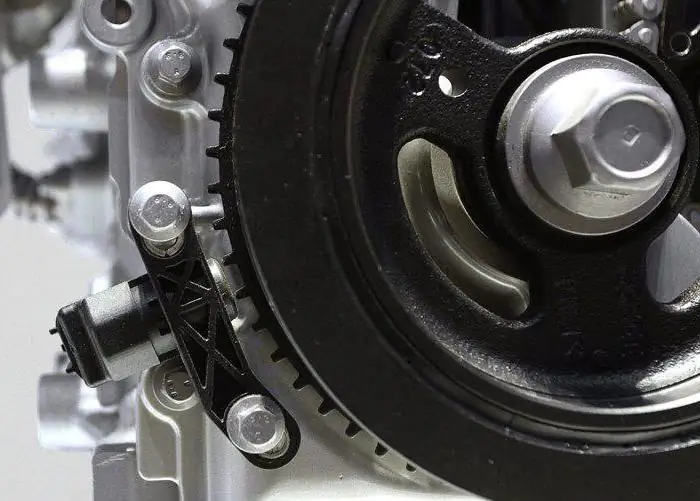2025 Author: Erin Ralphs | [email protected]. Last modified: 2025-01-22 21:14:09
Parking radars today occupy a mandatory place in the optional provision of a car. They still compete with rear view cameras, but for most drivers the choice is clear - in favor of parking sensors. Such systems not only help novice drivers get comfortable with the nuances of driving in tight spaces, but also save time for experienced car owners who need to park quickly and safely. How useful the decision to choose a given system will be depends on its configuration. Perhaps the most important component of such a radar is the parking sensor, which directly captures data on the position of the car relative to third-party objects. Therefore, his choice determines the efficiency of the system as a whole.

Sensor in the parking sensors
The work of modern parking sensors is based on the principle of ultrasonic radiation, the characteristics of which allow you to determine the levels of critical approach of the car to other vehicles, poles, curbs, trees, etc. The sensor in this system acts as an ultrasonic wave generator, also receiving and reflected impulse. The signal processed already in the central controller makes it possible to calculate the distance tonearby objects. As a rule, the parking system sensor covers a limited area, so it is almost never used in the singular. The minimum set assumes the presence of 2 sensors, and the maximum configuration allows the installation of 8 emitters on one side. The quality of the system is affected not only by the number of detectors, but also by the way they communicate with other components of the system.

Types of parking sensors
The main difference between parking sensors is the type of installation. In the families of large manufacturers, there are mortise and overhead models. Mortise-type devices are mounted in a bumper niche, requiring mechanical operations with metal. For reliable fixation, manufacturers also offer additional installation fittings. For example, the ParkMaster FJ parking sensor includes a rubber damper and an improved waterproofing system. As for the overhead models, they are attached using a special adhesive base. The advantages of this method of installation include the elimination of the need to cut the bumper.
Sensors also differ in the way the signal is transmitted. There are wired and wireless models. Devices that communicate with the central complex through wiring are stable in operation, but installation will not do without laying cables. For obvious reasons, a wireless parking sensor is easier to install, but many owners of such models note the influence of third-party radio interference on transmission qualitysignal.
Sensor specifications

One of the key performance characteristics of a sensor is its range. It determines the distance at which, in principle, it will be possible to fix the distance. Devices with low sensitivity indicators have a coverage area of the order of 30-40 cm. Premium versions according to this indicator can reach 120-150 cm. But this does not mean at all that models with a large working area are more profitable. They are more suitable for large cars, and a detector with a radius of up to 50 cm is quite suitable for a typical passenger car. Such modifications allow fewer false signals and are not so demanding on power supply. However, there are also combined installation schemes in which the rear parking sensors have an increased coverage range, and the front sensors have the same 30 cm. Another important characteristic is the case diameter. The sensor is a very compact device, but its design parameters can influence the future mounting method. Standard models have an average installation diameter of about 16-18 mm.
How to choose the right parking sensor?

Usually, sensors are included in ready-made kits with parking radars. But if you wish, you can include sensors from third-party manufacturers in it. To do this, it is necessary to evaluate the compatibility with the control complex according to the signal reception characteristics. Next, the configuration parameters of a particular model are determined - the dimensions of the detector, the shape and the presence of protectiveshells. It is desirable that the device has coatings that protect against dirt, moisture and mechanical shock. You should also consider the possibility of combining with a video camera. In particular, the rear parking sensors can be included in a single installation platform with a matrix that will also send a video signal to the monitor in the cabin. This possibility should be considered at the stage of purchase. Do not ignore the aesthetic nuance. In order for the sensor body not to stand out against the general background of the car exterior, it is necessary to decide in advance on the color scheme. In standard versions, manufacturers offer devices in silver and black, but there are other shades - including custom-made.
Optimal number of sensors

The more touch elements, the greater the coverage of "blind" zones and, accordingly, the lower the risk of collision. On the other hand, 6-8 emitters increase the sensitivity of the system, and with it the likelihood of false signals. Therefore, in choosing it is important to strike a balance determined by the needs of the driver himself. A minimum set of 2 sensors will allow easy movement next to adjacent bumpers and curbs. The optimal configuration, in which the parking radar is supplied, is 4 sensors on the rear side with 2 front sensors. In this case, safe parallel parking will also be possible.
Producers
The segment is quite saturated, since almost all companies producing electronics for cars participate in it. The leaders areBlackView, ParkCity and SHO-ME. You can also highlight the ParkMaster parking sensor, which, even in budget versions, has a wide coverage area and reliable protection against interference. The cost of products of these brands varies from 700 to 1500 rubles. average.
Conclusion

The success of parking radars with sensors is due to the fact that there are almost no alternative solutions on the market with this degree of efficiency. However, in the parktronic complex itself there is competition between individual components. You can replace the parking sensor with an electromagnetic tape. This is a strip on a metallized basis, which is glued from the inside of the bumper. This solution is advantageous in that it completely eliminates the installation of physical operations during installation and minimizes "blind" zones during operation. In turn, ultrasonic sensors benefit from a more accurate fixation of the object in the control field.
Recommended:
Phase sensor "Kalina". Replacing the phase sensor

Using the phase sensor, it is possible to track the position of the camshaft. It is not installed in carburetor engines; they were not on the first copies of injection systems either. But it can be found in almost all engines with 16 valves. An eight-valve engine is equipped with such devices only if they comply with Euro-3 toxicity standards, have a phased or sequentially distributed injection of the fuel mixture
ParkMaster parking sensor. Types, description

Car parktronics and parking sensors ParkMaster: equipment features, selection and installation. Popular models of parktronics ParkMaster
Crankshaft sensor. How to check the crankshaft sensor?

If the car does not start, the engine power drops, malfunctions occur, then the starter, battery or crankshaft sensor may be the cause of this. How to check the last element, many do not know. But the reason may be precisely in it
Sign "Parking is prohibited": the effect of the sign, parking under the sign and a fine for it

In a modern metropolis, the problem of stopping, and even more so parking, is sometimes much more serious than the movement itself. Still would! Cities are filled to overflowing with cars, and more and more often it turns out that the driver does not stop where it is possible, but where he can perch. And sometimes such tricks end in fines, and in the worst case, sending the car to a car impound
To make parking easier, buy parking sensors

Parking is often a problem for motorists, and it's not just about experience - it's just that our cities aren't geared up for this amount of traffic. Even if you are lucky, and a place for a car was found not far from the destination, then squeezing in there and not scratching your own or someone else's vehicle is sometimes very problematic. To facilitate maneuvers during parking, parking sensors have been developed

